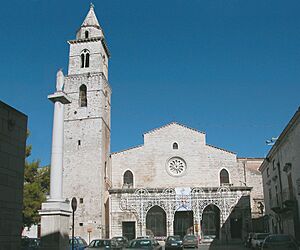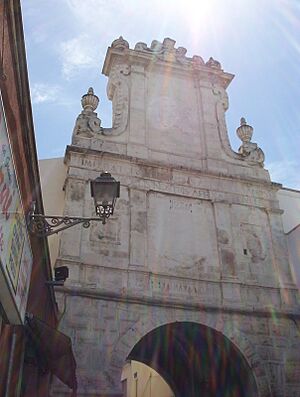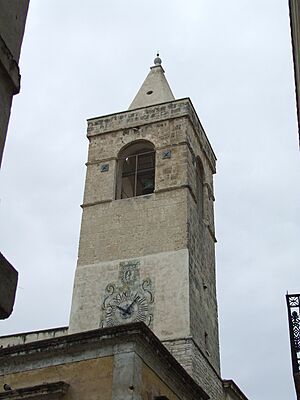Andria facts for kids
Quick facts for kids
Andria
Iàndrie
Àndros |
|||
|---|---|---|---|
| Città di Andria | |||

Castel del Monte
|
|||
|
|||
| Country | Italy | ||
| Region | Apulia | ||
| Province | Barletta-Andria-Trani (BT) | ||
| Frazioni | Castel del Monte, Montegrosso, Troianelli | ||
| Area | |||
| • Total | 402.89 km2 (155.56 sq mi) | ||
| Elevation | 151 m (495 ft) | ||
| Population
(31 March 2018)
|
|||
| • Total | 99,784 | ||
| • Density | 247.671/km2 (641.464/sq mi) | ||
| Demonym(s) | Andriesi | ||
| Time zone | UTC+1 (CET) | ||
| • Summer (DST) | UTC+2 (CEST) | ||
| Postal code |
76123
|
||
| Dialing code | 0883 | ||
| Patron saint | Richard of Andria | ||
| Saint day | April 4 | ||
Andria is a city in the Apulia region of Southern Italy. It's a busy place for farming and services. The city is famous for producing wine, olives, and almonds. It is the fourth-largest city in the Apulia region and the biggest in its province, Barletta-Andria-Trani. Andria is especially known for the amazing 13th-century castle called Castel del Monte.
Contents
Exploring Andria's Location
Andria is located in an area called the Murgia. It is about 10 kilometers (6 miles) from Barletta and the Adriatic coast. The city's area is quite large, making it the 16th biggest in Italy. It shares borders with several other towns like Barletta, Canosa di Puglia, and Trani.
Andria Through the Ages
Andria has a very long and interesting history, going back thousands of years!
Early Beginnings: Ancient Andria
The first signs of people living in the Andria area are from the Neolithic period, which was a very long time ago. People used tools made of stone, like obsidian knives. Later, during the Copper Age, people lived in caves carved into the soft rock called tuff.
In the Bronze Age, people started building round houses with cone-shaped roofs, similar to the famous trulli houses. Many ancient burial sites, called tumuli, have been found here.
Around 1000 B.C., the Iapygians lived in Apulia. Later, the Greeks came and founded a city called Netium near where Andria is today. This city was mentioned by ancient writers. When the city of Canne was destroyed in 216 B.C. during a big war, some people found safety in Netium.
Medieval Times: From Villages to a Fortified City
In 44 A.D., it is said that the apostle Peter visited Andria on his way to Rome. Later, around 492 A.D., Andria became a bishopric, which means it had its own bishop.
In 1046, a Norman leader named Peter took Andria from Byzantine rule. Andria, like other nearby towns, became a strong, fortified city. It had twelve towers, three gates, and a fortress.
In the 13th century, Andria was very important to King Frederick II. He loved the city and even had the famous Castel del Monte built nearby. This amazing castle is now a UNESCO World Heritage Site. Frederick II was so fond of Andria that he had a special phrase carved on one of the city gates, praising its loyalty. His son, Conrad IV, was born in Andria in 1228.
Later, under the rule of the Angevins, Andria was given as a gift to Beatrice, the daughter of Charles II of Naples. The city faced a siege in 1350 by the forces of Louis I of Hungary. During this time, a priest bravely hid the body of Saint Richard, the city's patron saint, to keep it safe.
In 1438, the body of Saint Richard was found again! To celebrate this event, a special festival called "Fiera d'Aprile" was started. This festival still happens every year from April 23 to 30, almost 600 years later.
Modern Era: Challenges and Growth
In 1503, a famous challenge called the "Disfida di Barletta" took place near Andria. This was a fight between Italian and French knights. The 13 Italian knights prayed in Andria's cathedral before the challenge.
Later, Andria came under Spanish rule. In 1552, the city was sold to Fabrizio Carafa, who became the first Duke of Andria. His family ruled the city for a long time. They built new churches and monasteries, like the Benedictine monastery and the Basilica of Santa Maria dei Miracoli, which holds a special old painting.
In 1799, during a time of big changes in Italy, Andria was besieged by the French army. The city stayed loyal to the old rulers, the Bourbons. For its loyalty, Andria was given the title of "Royal City."
During the 1800s, Andria grew and changed. The old feudal system, where land was owned by a few powerful families, was ended. This led to more people owning land and helped the city's economy grow. Andria became known for its special farm products and crafts.
The 20th Century and Beyond
In 1913, workers in Andria celebrated the first Labor Day. A film was even made showing the big parade through the city streets.
About 800 people from Andria died during the First World War. A monument was built in 1930 to remember them. After the Second World War, there was a period of economic difficulty, and many people had to move away to find work.
From the 1950s, Andria slowly started to recover. A new railway line opened in 1965, connecting Andria to other cities and helping its economy. In 2004, Andria became part of a new province called Barletta-Andria-Trani.
On July 12, 2016, a very sad railway accident happened between Andria and Corato. It was a serious event that caused many deaths and injuries.
Main Sights: What to See in Andria
Andria has many interesting places to visit, showing its rich history.
- Castel del Monte: This is the most famous sight, a unique 13th-century castle built by Emperor Frederick II. It's about 15 km (9 miles) from the city center and is a UNESCO World Heritage Site.
- Andria Cathedral: This church dates back to the 12th century and has an even older crypt from the 7th century.
- Ducal Palace: A strong old home that was updated in the 16th century.
- San Domenico: A church from the 14th century, changed over the years. It has a beautiful bust of Duke Francesco II Del Balzo.
- Sant'Agostino: This church was built in the 13th century by the Teutonic Knights. It has cool Gothic-style gates with special carvings and symbols of old noble families.
- San Francesco: A church and monastery with a peaceful courtyard from the 12th century.
- Communal Palace: The city's main government building.
- Santa Maria dei Miracoli: A basilica about 2 km (1.2 miles) from Andria. It holds a very old and respected Byzantine painting from the 9th-10th centuries. The basilica has three different levels, each with its own history and art.
- San Nicola di Myra: A 12th-century church that has been updated over time.
- Church of the Holy Cross: This church dates back to the 9th century. It has a main hall and two side sections. Its crypt was carved out of a tuff rock and includes natural caves.
- Santa Maria di Porta Santa: A church from the 13th century.
- Santuario Madonna dell'Altomare: Another important religious site.
Getting Around Andria
Andria is connected by the A14 National Motorway and a provincial road (SP 231) that links it to Bari and Foggia.
The city has a railway station on the Bari–Barletta railway line. The closest national train station (Trenitalia-FS) is in Barletta, about 10 km (6 miles) away. In 2016, there was a serious train accident on the line south of Andria.
The nearest airport is Bari Airport, which is about 45 km (28 miles) from Andria.
Sports in Andria
Andria is home to the football team Fidelis Andria. Their home games are played at the Stadio Degli Ulivi.
Famous People from Andria
Many notable people have come from Andria, including:
- Peter I of Trani (born before 1020), an early Norman count.
- Richard of Andria (died 1196), a bishop of Andria.
- Isabella II of Jerusalem (1212–1228), a queen buried in the Cathedral crypt.
- Isabella of England (1214–1241), another queen buried in the Cathedral crypt.
- Conrad IV of Germany (1228–1254), son of Frederick II, who was born in Andria.
- Isabella del Balzo (1465–1533), a Queen consort of Naples.
- Vincenzo Carafa (1585–1649), a Jesuit priest and writer.
- Ettore Carafa (1767–1799), a soldier and patriot.
- Corrado Ursi (1908–2003), an Italian cardinal.
- Lino Banfi (born 1936), a famous Italian actor.
- Antonio Matarrese (born 1940), an Italian football manager.
- Riccardo Scamarcio (born 1979), a well-known Italian actor and film producer.
International Connections
Andria is connected with other cities around the world through "twin town" or "sister city" partnerships. This helps cities share culture and ideas.
Twin Towns – Sister Cities
Andria is twinned with:
See also
 In Spanish: Andría para niños
In Spanish: Andría para niños








